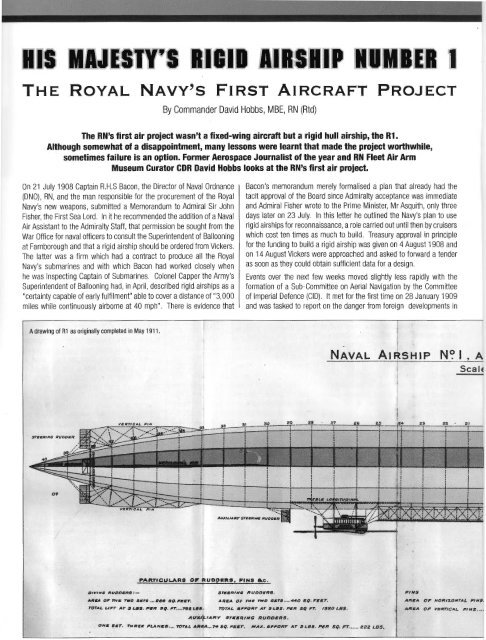VOL 71 No4 - Navy League of Australia
VOL 71 No4 - Navy League of Australia
VOL 71 No4 - Navy League of Australia
Create successful ePaper yourself
Turn your PDF publications into a flip-book with our unique Google optimized e-Paper software.
THE ROYAL NAVY'S FIRST AIRCRAFT PROJECT<br />
By Commander David Hobbs, MBE, RN (Rtd)<br />
The RN's first air project wasn't a fixed-wing aircraft but a rigid hull airship, the R1.<br />
Although somewhat <strong>of</strong> a disappointment, many lessons were learnt that made the project worthwhile,<br />
sometimes failure is an option. Former Aerospace Journalist <strong>of</strong> the year and RN Fleet Air Arm<br />
Museum Curator CDR David Hobbs looks at the RN's first air project.<br />
On 21 July 1908 Captain R.H.S Bacon, the Director <strong>of</strong> Naval Ordnance<br />
(DNO), RN, and the man responsible for the procurement <strong>of</strong> the Royal<br />
<strong>Navy</strong>'s new weapons, submitted a Memorandum to Admiral Sir John<br />
Fisher, the First Sea Lord. In it he recommended the addition <strong>of</strong> a Naval<br />
Air Assistant to the Admiralty Staff, that permission be sought from the<br />
War Office for naval <strong>of</strong>ficers to consult the Superintendent <strong>of</strong> Ballooning<br />
at Farnborough and that a rigid airship should be ordered from Vickers.<br />
The latter was a firm which had a contract to produce all the Royal<br />
<strong>Navy</strong>'s submarines and with which Bacon had worked closely when<br />
he was Inspecting Captain <strong>of</strong> Submarines. Colonel Capper the Army's<br />
Superintendent <strong>of</strong> Ballooning had, in April , described rigid airships as a<br />
"certainty capable <strong>of</strong> early fulfilment" able to cover a distance <strong>of</strong> "3,000<br />
miles while continuously airborne at 40 mph ". There is evidence that<br />
Bacon 's memorandum merely formalised a plan that already had the<br />
tacit approval <strong>of</strong> the Board since Admiralty acceptance was immediate<br />
and Admiral Fisher wrote to the Prime Minister, Mr Asquith , only three<br />
days later on 23 July. In this letter he outlined the <strong>Navy</strong>'s plan to use<br />
rigid airships for reconnaissance, a role carried out until then by cruisers<br />
which cost ten times as much to build. Treasury approval in principle<br />
for the funding to build a rigid airship was given on 4 August 1908 and<br />
on 14 August Vickers were approached and asked to forward a tender<br />
as soon as they could obtain sufficient data for a design.<br />
Events over the next few weeks moved slightly less rapidly with the<br />
formation <strong>of</strong> a Sub-Committee on Aerial Navigation by the Committee<br />
<strong>of</strong> Imperial Defence (CID). It met for the first time on 28 January 1909<br />
and was tasked to report on the danger from foreign developments in<br />
A drawing <strong>of</strong> R1 as originally com pleted in May 1911.<br />
NAVAL AI SHIP N I<br />
A<br />
Seal~<br />
PARTICULARS Of" RUDDEitS, FINS &c .<br />
DIVINS RUDDERS : - Srt!ERING RUDDERS . FINS<br />
AR£A OF rHE TWO S~TS -- 2611 S9- FlEET.<br />
TOTAL LIFT AT 3 LIJS. P~R sq. FT . ...'1"98 LBS .<br />
AREA o ·~ THI! TWO S6TS ... . 4.0 5". FEET. AREA OF HORIZONTAL FINS.<br />
TOTAL 6.FFOifltT AT 3LBS. PER Sli/ FT. 13ZO LBS. AREA OF VERTICAL F I NS . ...<br />
AUXILIARY STIEI!:RING RUDDERS •<br />
. ON I! S£T. THREE PL..AN£8 .. _ TOTAL A.REA _. 7 4 S('. FEET. MA.X. . EFFORT AT 3 LBS. P~R S(l. FT. ..... 222 LBS.

















